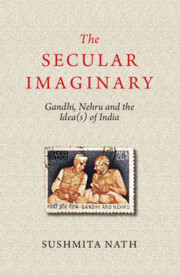Book contents
- Frontmatter
- Contents
- Preface
- Acknowledgements
- Introduction
- 1 Debating the Secular beyond the West
- 2 Gandhi’s Ashram and Political Thought: A Counter-narrative of Secularity
- 3 Gandhi’s Associationalism: A Non-state Alternative to Liberal Secularism?
- 4 Was Nehru Nehruvian? Religion, Secularity and Nehruism
- 5 Nehru and the Politics of Liberalism of Fear
- Conclusion
- Bibliography
- Index
3 - Gandhi’s Associationalism: A Non-state Alternative to Liberal Secularism?
Published online by Cambridge University Press: 27 September 2022
- Frontmatter
- Contents
- Preface
- Acknowledgements
- Introduction
- 1 Debating the Secular beyond the West
- 2 Gandhi’s Ashram and Political Thought: A Counter-narrative of Secularity
- 3 Gandhi’s Associationalism: A Non-state Alternative to Liberal Secularism?
- 4 Was Nehru Nehruvian? Religion, Secularity and Nehruism
- 5 Nehru and the Politics of Liberalism of Fear
- Conclusion
- Bibliography
- Index
Summary
INTRODUCTION
Notions such as ahimsa (non-violence), truth as an experiential notion, dharma (faith and/or duty), exemplary action, self-discipline and sacrifice (tapasya) are some of the recurring motifs in Gandhi's conception of religion. As seen in the previous chapter, Gandhi transforms these religious-moral ideas and ideals into political conceptions and employs them in the political practice of ahimsa and satyagraha (the political tool of ahimsa, literally insistence on truth). Gandhi's inclusion of religion in the public-political sphere shows that he was not simply engaging in an exercise in the semantics of religious experimentation. That is why it was asserted in the previous chapter that Gandhi's religious and moral thought and his political action are inseparable, such that the spiritual Gandhi cannot be understood without the political one. In this chapter, I will look at how, after his return to the Indian subcontinent from South Africa in 1915, Gandhi practised and propagated his religious politics in relation to India's national politics and the freedom movement, and thereby examine the role and relationship he sought among religion, state and society. In order to do so, I shall retrace some of the major sociopolitical events and issues in Indian politics, where Gandhi used his religious-moral politics and showed how, as a ‘practical idealist’, he put the idealism that animated his religious politics into political practice. By focusing on Gandhi's political action, this chapter assesses his ideas in terms of its efficacy on society and politics.
In this chapter, I will shed light on Gandhi's religious politics with the help of three broad themes: unity between religions, unity within religion and religious tolerance. The outline of the chapter is as follows: I begin the first section of the chapter by distinguishing Gandhi's religious politics from other types of exclusionary politics, like communal politics in India, where religion is also central to political action. Gandhi's religious politics is demonstrative of, what I shall call in the following pages, religion in politics, which, in seeking unity in difference and justice for all, emerges as an inclusive political ideal and practice. By contrast, forms of ethno-nationalist politics, such as communalism, are divisive and exclusionary, and the use of religion there, I argue, is usually demonstrative of politics of religion. In the second section, I argue that Gandhi sought common action and political unity via three interrelated and supplementary forms of, what I call, ‘associationalism’.
- Type
- Chapter
- Information
- The Secular ImaginaryGandhi, Nehru and the Idea(s) of India, pp. 98 - 140Publisher: Cambridge University PressPrint publication year: 2022



